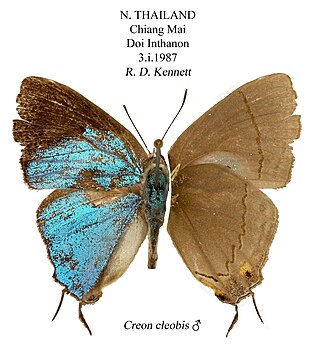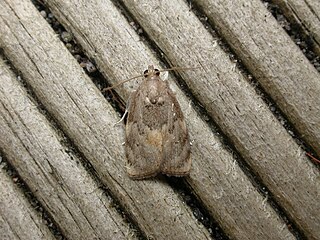
The red underwing is a moth of the family Erebidae. The species was first described by Carl Linnaeus in his 1767 12th edition of Systema Naturae.

Apamea monoglypha, the dark arches, is a moth of the family Noctuidae. The species was first described by Johann Siegfried Hufnagel in 1766. It is a common, sometimes abundant, European species. It is found in most of Europe except northernmost Fennoscandia and the southern parts of the Iberian Peninsula and Greece. The species is also found in Anatolia, Turkestan, Western Asia and Central Asia, Siberia and Mongolia. In the Alps it is found up to heights of 2,500 meters. The smaller subspecies sardoa is found on Sardinia and Corsica.

Apamea crenata, known as the clouded-bordered brindle, is a moth in the family Noctuidae. It is distributed throughout the Palearctic realm. In the North it crosses the Arctic Circle, in the Mediterranean it is found only in cool locations and mountains avoiding very hot areas. In the Alps, it rises to an altitude of about 2000 metres.

Apamea remissa, the dusky brocade, is a species of moth of the family Noctuidae. It is distributed throughout Europe and Turkey, ranging across the Palearctic realm to Siberia, Manchuria and Japan. It has also been reported from Alaska.

Chliaria othona, the orchid tit, is a species of lycaenid or blue butterfly found in Asia.

The broadtail royal is a butterfly in the monotypic genus Creon, in the family Lycaenidae. It is found in South Asia.

Catocala promissa, the light crimson underwing, is a moth of the family Erebidae. The species was first described by Michael Denis and Ignaz Schiffermüller in 1775. It can be found in Europe and Anatolia up to Armenia.

Mesapamea secalis, the common rustic, is a moth of the family Noctuidae. The species was first described by Carl Linnaeus in his 1758 10th edition of Systema Naturae. It is found in Europe, north-west Africa, Turkey and northern Iran.
Dipriodonta is a monotypic genus of moths belonging to the subfamily Drepaninae and contains Dipriodonta sericea as only species, which is found in India.

Grammodes stolida, the geometrician, is a moth of the family Erebidae. The species was first described by Johan Christian Fabricius in 1775. It is found in Africa, southern Europe, most of Asia and Australia. It migrates to central and northern Europe as far north as England, Denmark and Finland.

Nycteola revayana, the oak nycteoline, is a moth of the family Nolidae. The species was first described by Giovanni Antonio Scopoli in 1772. It is found from Europe and east across the Palearctic to Japan and India.

Lichenaula lichenea is a species of moth of the family Xyloryctidae. It is known in Australia from the Australian Capital Territory, New South Wales and Queensland.
Striginiana nobilis is a moth in the family Eupterotidae. It was described by William Jacob Holland in 1893. It is found in Gabon.
Imma epicomia is a moth in the family Immidae. It was described by Edward Meyrick in 1906. It is found on the Solomon Islands.
Imma autodoxa is a moth in the family Immidae. It was described by Edward Meyrick in 1886. It is found on Fiji.

Imma acosma is a moth in the family Immidae. It was described by Alfred Jefferis Turner in 1900. It is found in Australia, where it has been recorded from Queensland and New South Wales.
Imma albifasciella is a moth in the family Immidae. It was described by Arnold Pagenstecher in 1900. It is found on the Bismarck Archipelago and in Australia, where it has been recorded from Queensland.
Imma hemixanthella is a moth in the family Immidae. It was described by William Jacob Holland in 1900. It is found on Buru in Indonesia.
Imma lichneopa is a moth in the family Immidae. It was described by Oswald Bertram Lower in 1903. It is found in Australia, where it has been recorded from Queensland.
Mesoscia pascora is a moth of the family Megalopygidae. It was described by William Schaus in 1900. It is found in Brazil.











